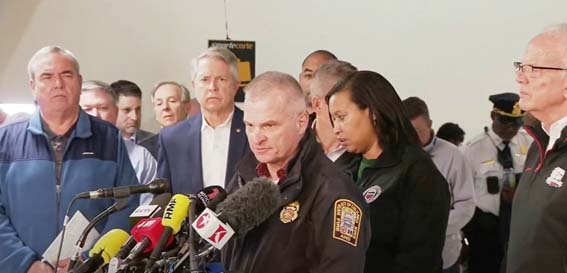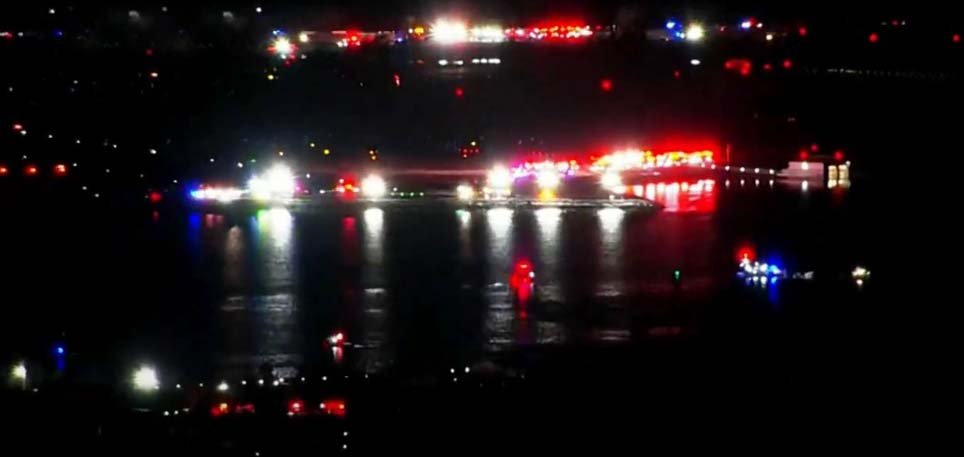Monday 30 January 2030
Near Ronald Reagan Washington National Airport, an American Airlines regional plane crashed midair with a U.S. Army Black Hawk helicopter on Wednesday night in a horrific catastrophe. En route from Wichita, Kansas, the passenger jet—identified as Flight 5342—carried sixty people and four crew members. Three military men were riding in the Black Hawk helicopter. Authorities have verified that neither airplane nor any other vehicle is expected to produce survivors.
Details of the Collision
Aviation and defense sources claim that the incident happened while the jet was nearing Reagan National Airport at around 8:45 PM EST. Preliminary accounts indicate that little under a mile from the airport, the Army UH-60 Black Hawk helicopter on a regular training operation came into the path of the Bombardier CRJ-700. The impact made both airplanes fall to bits midair, sending flotsam and jetsam pouring down into the Potomac Stream and close by neighborhoods in Arlington, Virginia.
Onlookers recounted seeing a gigantic flame overhead, trailed by a raucous blast. “It resembled a thunderbolt that shook our windows,” claimed John McAllister, a neighborhood occupant who was walking his canine at that point. “Then we witnessed flames and debris falling from the sky. It was terrifying.”
Search and Recovery Efforts
Emergency personnel rushed at the area within minutes, initiating a major search and recovery effort. However, the mix of freezing temperatures and firm flows in the Potomac River has confused operations. Starting around earlier today, 27 bodies have been recuperated from the destruction, alongside other airplane parts. Search workers have been utilizing sonar technology to identify further debris beneath the river’s surface.
“At this stage, we have shifted from a rescue to a recovery mission,” stated D.C. Fire and EMS Chief John Donnelly. “Our hearts go out to the families of the victims. We are doing everything in our power to collect remains and offer closure to the bereaved family.”
Potential Causes Under Investigation
The Federal Aviation Administration (FAA) and the National Transportation Safety Board (NTSB) have initiated an investigation into the reason for the catastrophe. Starter discoveries uncover that the chopper was leading a routine flight way allowed using airport regulation. However, conflicting sources indicate that an unanticipated change in altitude may have placed it in the jet’s flight path.
Aviation safety experts have pointed out the complexities of airspace surrounding Reagan National Airport, one of the busiest in the country. “Military and civilian aircraft share controlled airspace, but strict coordination measures are in place,” said former NTSB investigator Robert Halvorsen. “We need to determine whether there was a miscommunication between air traffic controllers and the pilots.”
Black boxes from both airplane have been recuperated and are being examined at the NTSB central command in Washington, D.C. Authorities anticipate a fundamental report within the following two weeks, with a full examination probably requiring several months.
Community and International Impact
The disaster has sent shockwaves across the whole local area and then some. Among the passengers were U.S. figure skaters, mentors, and family members getting back from a training camp. Russian media stated that two previous world champions—a married couple—were also on board, underscoring the international effect of this calamity.
Families of the victims have started arriving in Washington, D.C., to receive updates and support from crisis teams. “This is the worst day of my life,” said Karen Roberts, whose daughter was on the aircraft. “She was coming home after six months away. I can’t believe she’s gone.”
The event has also aroused worries about military aviation operations in civilian airspace. Congress is slated to hold hearings on proposed regulation reforms to increase coordination between military and commercial aviation agencies.

Historical Context and Similar Incidents
While midair hits are unusual, they have happened in the past with dismal effects. In 1958, Joined Carriers Flight 736 crashed into a U.S. Flying corps warrior plane, forcing enormous modifications in aeronautics security requirements. Essentially, in 2006, a Gol Transportes Aéreos Boeing 737 collided with an Embraer Heritage 600 personal luxury plane over Brazil, killing everybody of the 154 individuals ready.
“Every time an accident like this occurs, the industry learns valuable lessons,” said aviation historian Mark Davidson. “It often leads to tighter regulations, improved technology, and new safety protocols to prevent future tragedies.”
Political and Regulatory Reactions
D.C. Mayor Muriel Bowser expressed tremendous sorrow in a public statement, adding, “Our community mourns the loss of so many lives. We will do everything we can to support the families and conduct a thorough investigation.”
The Biden administration has requested a complete examination of airspace management procedures to prevent repeat disasters. Transportation Secretary Pete Buttigieg underlined the significance of fixing any gaps in coordination between military and civilian flight operations. “This accident underscores the need for seamless communication and operational clarity in shared airspace,” he remarked.
President Donald Trump also published a message via his Truth Social platform, calling the disaster a “heartbreaking tragedy” and extended sympathies to the families of the victims. “This sad occurrence reminds us of the bravery of our military troops and the need of maintaining the greatest aviation safety standards. We must enforce accountability and prevent such calamities from happening again,” he stated.
The FAA is anticipated to propose new regulations demanding more separation between military and civilian aircraft operating near major airports. Additionally, an independent aviation safety group will be established to recommend further steps.
What’s Next?
As investigators continue their work, the aviation world will be looking attentively for the final report. If miscommunication or system problems are revealed to have played a role, big policy revisions may follow. In the meantime, the groups of the casualties face an inconceivable misfortune, while authorities work to guarantee that such a disaster at no point ever occurs in the future.
Related Video (Video Link)
Sources:
- The Wall Street Journal (wsj.com)
- CNN (cnn.com)
- The Washington Post (washingtonpost.com)
- NTSB Official Report (ntsb.gov)
- FAA Aviation Safety Database (faa.gov)

